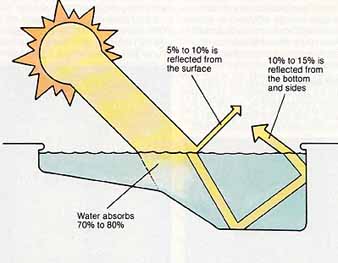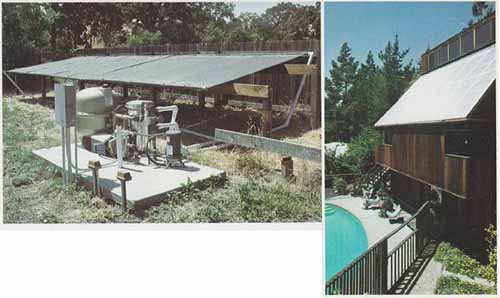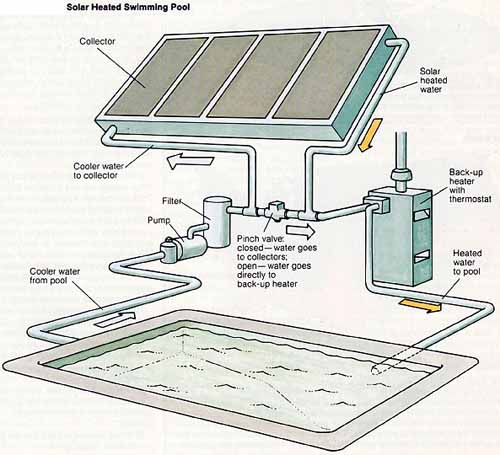When you stop to think about it, solar energy seems to be a natural way to heat a swimming pool. After all, the water in the pool acts as a solar collector to some degree, absorbing about 70 to 80 percent of the available sunlight. However, this absorption doesn’t necessarily bring the water up to an acceptable level of comfort, so you may want to enhance the water’s natural collection ability by using an active solar system to heat it.
Conventionally, swimming pools are heated by natural gas or, less frequently, by electricity. The cost of heating a 16- by 36-foot pool to 80°F during the high-sun season (May to September), without any energy conservation measures, can equal the cost of driving a 20 mpg car 15 thousand miles. Even if you were willing to spend that much money providing all this heat through fossil fuel, an increasing number of lo cal governments are restricting by law the use of fossil fuels for this purpose.
Solar heating offers a viable alternative; in fact, heating a pool with solar energy is one of the easiest uses of the whole solar technology. Why not use the sun to heat the vast expanse of water that swimming pools lay bare to the sun as well as to the air? Three characteristics of pools make them particularly adaptable to solar heating: (1) the water retains heat extremely well; (2) swimming pools are heated to relatively low temperatures; and (3) out door pools are likely to be heated only during high-sun seasons, in any case.
As with all other aspects of solar heating, the first step is to conserve what you already have. Whether or not you use a conventional heating system, you can conserve what ever heat your pool absorbs from the sun by using a pool cover, particularly at night and on cloudy days. The same holds true when you have a solar pool heating system. There is no point in heating water that is cooled immediately by evaporation and radiation. There fore, if you are considering a switch from a conventional system to a solar system, or thinking about installing a solar system alone, be sure to complete the picture with proper conservation measures.
An active solar swimming pool heater functions along the same lines as any other active solar water heater, except that the storage tank is also the point of distribution. A pump is used to convey water to be heated to the collectors, and to carry heated water from the collectors to the pool. As with other hot water systems, if there is any possibility of freezing, you must add antifreeze to the system, and use a heat exchanger to transfer heat from the solar-heated water to the water entering the pool. The simplest freeze protection for a seasonal solar pool heater is to drain the collector system during the winter.
An active liquid solar heating system is used to heat pools. All its parts should be compatible with your existing mechanism, since the pool water circulates both through your collector panels and through your present filter pump.
A swimming pool heater is a separate installation from the home’s regular furnace. It is sometimes housed in its own small shed at the end of a mechanical chain that begins with a power pump, and then continues with a filter system, the heater, a chlorinator, and finally the pool itself.
When you install solar pool heating, you break into the piping that runs between the filter and the heater; there a “pinch” or “gate” valve is installed, whose function is to redirect the circulating water to your solar collectors. The rerouted and solar-heated water returns to this break by way of a second pipe, and then moves on to the existing, thermostatically con trolled heater. If your solar collectors have warmed the water sufficiently, it bypasses your heater. But if you have set your thermometer for, say, 80° F, and the water flowing from the collectors reaches the heater at 75°F, the heater kicks in. The operation is similar to any other solar heating household application that includes a thermo statically controlled backup system. Cool water flows from the bottom of the pool through the pump and filter, up or out to the collector panels, and back in to the pool. Standard solar swimming pool heating systems also provide a heat sensor to start the system up and turn it off as the water’s temperature fluctuates, and a vacuum relief valve to permit the system to drain, which minimizes their chances of freezing in winter.
The important difference between solar-heated swimming pools and other active solar heating applications is the expense for the initial installation. In most locations, pool collectors do not have to be glazed. The most common kind of solar collector for pool heating is a 10- by 4-foot sheet of extruded plastic, including about 250 quarter- inch tubes lying side by side, in which the water can be warmed. The panels, which cost about $20 to $35 per square foot installed, are light enough to handle fairly easily, and to install on most roof tops without added structural support. You should have at least enough collector area to equal 50 to 75 percent of the surface area of your pool. This will enable you to maintain a pool temperature of around 78° F. Because these panels are going to be used exclusively during the high-sun season, neither their orientation nor their tilt is as important as it is with solar space or domestic water heating.
Indoor pools can be solar-heated just as outdoor pools can be. However, they need only about half the collection area that an outdoor pool needs. This is be cause they are less liable to lose massive amounts of heat irretrievably—the convected heat loss warms the space around the pool instead of disappearing into the atmosphere.

Swimming Pool Sunlight Absorption: 5% to 10% is reflected
from the surface; 10% to 15% is reflected from the bottom and sides; Water
absorbs 70% to 80%

(Left) A complete solar swimming pool heating system, before it
is disguised by landscaping. The light, plastic collectors are up on
racks; the circulating system stands below. (Right) A similar system,
installed and in use. The collectors are fiberglass, and have been placed
on the house to function as the roof, rather than being placed on the
roof. In any case, solar swimming pool collectors are generally unglazed, and are, therefore, much lighter in weight than water or space heater
collectors. As a result, almost any roof can stand up under their weight
without additional structural supports.
Next: Is Solar for You; Geography and Climate
Prev: Active Hot Water Systems
